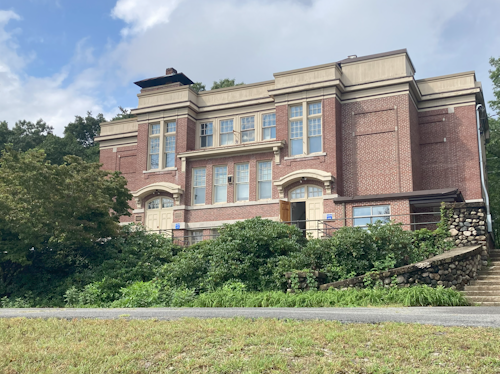Above: Town officials are still uncertain about the future of the nationally recogonized historical building* on the hill overlooking Highland Street. (photo by Beth Melo)
Earlier this summer, I previewed that the Select Board would be digging into what to do with the Town’s 21 Highland Street property, site of the South Union Building. Last week, the board discussed options, including selling or demolishing the historically significant* but energy inefficient building.
Following a long discussion and some passionate public comment, the board decided they will draft a Request for Proposals for a Feasibility Study to further examine potential uses.
Chair Andrew Dennington set the stage by reminding that this year’s board goals included determining the future use of the expensive-to-maintain building and that in 2021 the board had unsuccessfully sought to sell it. (After the RFP process failed, the board pulled the Article that would have sought voter approval.)
Member Al Hamilton then discussed the condition of the building. He focused on inefficiencies for heating and cooling and future repair costs. He judged that it would realistically cost millions to bring the building up to modern, efficient standards.
He then went through what he saw as all of the board’s 8 options. Half of those choices either require, or allow the possibility of, demolishing the building. Three require investing in renovating the building, one maintaining status quo.
Half of the options, and a lot of discussion, focused on ways to develop the lot and/or building for affordable housing. Members referred to the report written by a Town subcommittee outlining the possibilities.
Dennington noted that subcommittee Chair Thomas Bhisitkul had advised that the next step would be to pay for a Feasibility Study to further vet their findings. Member Sam Stivers agreed that a Feasibility Study would make sense.
Hamilton wondered if the board first wanted to eliminate any of the options he listed. Member Kathy Cook suggested that since keeping or razing the building drastically changes the economics, the board may first need to decide whether or not to preserve it.
21 Highland Street Subcommittee member Joe Palmer commented to the board that since their work was solely focused on studying options for Affordable Housing at the site, they hadn’t solicited feedback from area residents.
He floated an example of an unrelated alternative use — installing a pool and using the building only in the summer as a bath house to avoid the heating costs. But his broader point was the need to solicit feedback from community stakeholders, including other boards and committees, about how they want to see the property used.
That was echoed by Kristen LaVault. The Recreation Commission and Community Preservation Committee member said she was speaking as an individual but with context from discussions at past meetings. She pushed the Select Board to not eliminate any options or consider demolishing the building before gathering feedback from stakeholders. Those included area residents and the Recreation, Historical Commission, and Open Space Preservation commissions.
LaVault indicated that the financial figures she had for maintaining the building were different than the ones cited by Hamilton. Until that could be cleared up, she objected to Hamilton referring to the building as a money pit.
LaVault also disagreed with an assertion Cook had made that there are better options for the two small departments in the building to be moved to. She stressed that the building is fully utilized by the Town, including for storage. She noted that alternatives haven’t been suggested that would replace the basement studio used for pottery classes or the gym where classes like Karate take place.
Justin Shatraw, who lives across from the building criticized officials for not having solicited feedback from his section of town. He spoke passionately in favor of preserving the building and its surrounding land, including the hill that residents use for sledding. He worried about an inappropriate project getting “wedged” into the space. He summed up:
I don’t care if it’s a money pit, it’s my tax money, too. I’d rather sink something into Historical preservation on that side of town than steamroll it into duplexes that will look like trash.
Also discussed by Select Board members in the meeting is the role the parcel is likely to have in the Town’s MBTA zoning efforts (given its proximity to the commuter rail).
The board decided that they would draft an RFP for a Feasibility Study to look at property options beyond just affordable housing.
LaVault urged that other committees should be involved in the drafting process before something is made public. Board members disagreed. Instead they promised to alert relevant committees when the draft would be on their agenda so they could provide public comment.
*The South Union Building was built in 1912 and is on the National Register of Historic Places. When the Historical Commission was asked to weigh in on the potential building disposition in 2021, they responded with a letter stating:
the SHC strongly encourages that the town considers sale only to buyers who are committed to preserving the exterior of this structure. A Preservation Restriction would be ideal for this unique building and guarantee its place in Southborough’s landscape and history for years to come.


